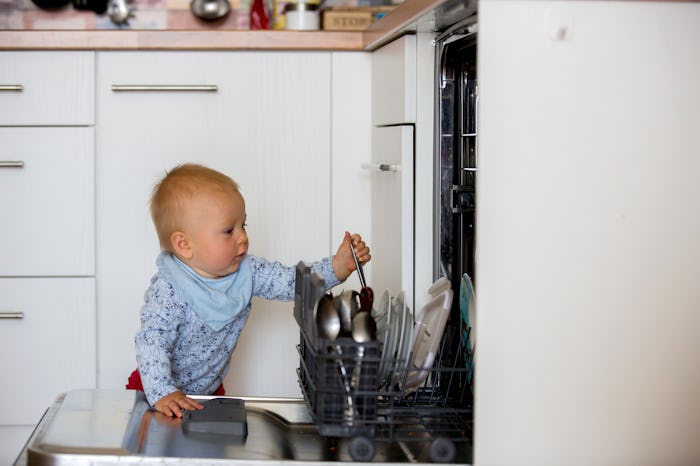Life

Here's What Most Parents Forget To Do When Childproofing The Kitchen, Experts Say
Baby milestones seem to happen overnight. It's like babies go from rolling over to pulling up before you can blink. My one-year-old son recently started walking a few days before his birthday. Almost immediately, I realized our efforts to childproof the kitchen were woefully inadequate. My son specialized in getting into mischief I had never considered, like pulling at the corners of the kitchen mats to gnaw on them. I thought I had all my bases (and corners) covered by locking the cabinets.
Michelle Kauffman, vice president and co-owner of Baby Proofing Montgomery, tells me it's true that the largest project to tackle is securing all the kitchen drawers and cabinets. "If you have a big kitchen, you often forget what you have in all of those drawers," she says. And she advises parents should start this process before your baby is rolling over and beginning to show signs of crawling. "Every child develops at a different rate and speed," she explains, "but in general terms, we typically say: by about 6 months [of age] you want to start."
However, parents shouldn't rest easy once they've latched every cabinet and locked every drawer. "Childproofing is so much more than [baby gates and latches]" explains Colleen Driscoll, executive director of the International Association for Child Safety (IAFCS), a trade organization for childproofing professionals.
After speaking with Driscoll, I was surprised to learn how much of baby-proofing a kitchen can be simple. Both Driscoll and Kauffman recommend parents literally look at the kitchen from a tot's perspective to gain a comprehensive view of what needs to be childproofed. Get down and dirty and crawl on all fours. I missed one important part of this exercise when I baby proofed: make sure you take note of your baby's height and reach once they start pulling up. Few things are more alarming than realizing too late, "I didn't know the baby could reach that high!"
The mantra "Up, up, and away" is a good rule of thumb for preparing to keep children safe in the kitchen area. Move poisonous items up out of reach and lock them up. If a moveable fixture becomes a problem, take it away. So, for example, the best fix for my son chewing on the kitchen mats is removing them until he is old enough to grow out of the habit. We also had to move our dog's food and water bowl to prevent the baby from playing with them.
Parents can also help prevent accidents by removing items hanging off countertop edges such as junk mail, magazines, or other objects. Cover stove knobs and remove hanging towels or dishrags from reach. "Your kids are going to want to get to it. And they'll find a way," Kauffman says. "When they're moving and crawling, they'll pull a chair over and crawl up and oftentimes fall off," she adds. Fixtures that stay on counter surfaces, like knife blocks, can be pushed toward the backsplash and turned sideways to prevent yanking.
Speaking of falling objects: Kauffman also discourages parents from using place mats and tablecloths because toddlers can pull them (and hot food) down on their heads.
Kitchen islands often get overlooked during the baby-proofing process. The sharp corners can be padded with guards if they become an issue. While it's easy enough to block low-level island electrical outlets with outlet caps, parents should be aware toddlers around 15 months old love to push and pull objects out of outlets, nurse practitioner Meghann Wellard told Today. Make sure the outlet covers you choose fit snugly, because some allow wiggle room for little fingers.
"There's a big misconception that just because [a device is] sold as a safety product that it's gone through testing or meets standards. Most childproofing products do not have a standard that they must adhere to," says Driscoll. Those devices can still appear on store shelves or for sale at online retailers. Driscoll tells Romper that because of this, parents might be unaware of childproofing items that have poor design or inadequate materials.
Kauffman also warned dangling cords, especially for phone, tablet, or laptop chargers, pose a danger for curious tots. Remember to plug your tech devices into outlets babies and toddlers cannot reach.
If covering every possible hazard in the kitchen feels overwhelming, child safety experts like the IAFCS want caregivers to know it doesn't have to be. Certified baby proofing specialists can provide comprehensive consultations tailored to your home, offer recommendations on tried and proven safety products, and even install devices.
Ultimately, childproofing is meant to complement parental supervision and give you peace of mind. The most stressful parts of being a parent are the times when your eyes can't be everywhere at once. But Driscoll shared three easy-to-remember childproofing tips: Rearrange your home, change your habits, or remove the problem altogether.
Sometimes, for items like hard furniture or glass, she admits, "There aren't always practical ways to childproof. You just have to take [an item] out of the environment. Maybe give it away or store it away." And remember that it's only temporary — after all, babies and toddlers won't be little forever.
Experts:
Michelle Kauffman, vice president and co-owner of Baby Proofing Montgomery
Colleen Driscoll, executive director of the International Association for Child Safety (IAFCS)
Edit note: This post has been updated to clarify when experts advise parents to begin the baby-proofing process